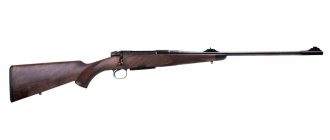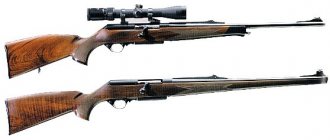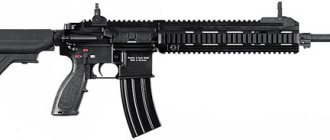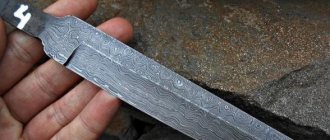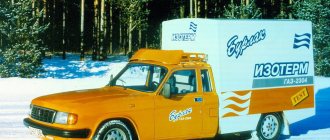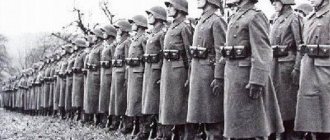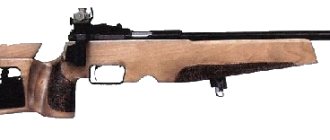German repeating rifle
Straight action rifle
| Heim SR 30 | |
| Type | Straight action rifle |
| Place of origin | Germany |
| Production history | |
| Designer | Peter Fortner Jr. |
| Produced | 1998-present |
| Options | Classic, Classic Kayler, Premium, Classic Concord, Super Classic, Royal, Grand Royal |
| Characteristics | |
| Weight | 3.1-3.6 kg |
| Length | 1110-1140 mm (overall), 500-610 mm (barrel) |
| Cartridge | Several, see below. |
| Action | Roller locked, straight pull |
| Attractions | Open sight or scope ready |
Heim SR 30
is a straight pull rifle manufactured in Germany by Heym. The rifle is also available in a left-handed version. [1]
Locking mechanism[edit]
We disassembled the Heym SR 30 shutter.
The mechanism uses 6 ball bearings around the circumference of the bolt head as locking elements. As the bolt handle is pulled forward, it forces the central plunger down into the bolt body, forcing the 6.5 mm (0.256 in) diameter ball bearings to lock into negative shaped (concave) recesses in the receiver. The plunger retracts when the bolt handle is pulled back, allowing the locking bearing to retract into the body of the bolt so the bolt can open.
Primary extraction is accomplished by retracting the bolt handle, which uses a lever on the opposite side of the bolt to rotate the handle to the open position, which provides a mechanical advantage. The mechanism was designed by Peter Fortner Jr. Another example of a semi-rigid bolt lock is the Anschütz 1827 Fortner rifle, also designed by Peter Fortner Jr.
Heim states that they have successfully tested the SR 30 locking mechanism by the CIP accredited Suhl testing laboratory, loaded to 800.0 MPa (116,030 psi).[2][3] The bolt can be classified as a semi-rigid type since the locking elements are movably mounted on the shutter.
The bolt handle can be placed in three positions: (1) open, (2) locked and unlocked, and (3) locked and cocked. [4]
The HEYM SR-21 carbine is a child of the 21st century...
History of the issue and logic of choice
The city trapper's choice is the Heym SR-21 rifled hunting carbine, Normal package with three barrels/calibers: 9.3×62, 30-06 Sprg., 223 Rem. The purpose is exclusively for hunting.
At the end of 2004, it was decided to purchase an imported rifled carbine. Initially, being a patriot and a person brought up by the ethical standards of the USSR and ideologically devoted to domestic weapons, I drew attention to Russian weapons. But upon closer acquaintance with the modern products of a number of Russian enterprises, I decided to refuse to purchase a domestic carbine. Engineering thought, after a long analysis of periodical literature and the Internet, set the task: with one license, purchase a fashionable modern modular system in calibers that will cover the entire range of Russian hunts. The choice of caliber line was determined by Russian hunting (this is a separate discussion).
I chose the carbine based on the principle of “what fits in my hand,” since I liked the models presented in stores equally. All the European rifles we looked at in approximately the same price category (Heym 30, Blaser R93, Mannlicher, Sauer 202) were worthy of admiration. To be honest, I was initially set up for Blaser. But... The Blaser turned out to be a bit short, the 30 Heym simply did not fit in the hand, the Mannlicher did not have interchangeable barrels, the same can be said about the conditional modularity of the Sauer 202 and the limited selection of three-ring carbine in stores. Honestly, the appearance (wood, twisted trunks) is the richest of the “Mannlicher”, but... maybe next time. Emotions, my friends, emotions... tactile sensations and energy... no pragmatism or logic. This is how we, hunters, always choose a companion and a reliable comrade. Axiom - when buying an expensive carbine, do not skimp on high-quality optics, brackets, cartridges and a qualified installer. A good carbine is a one- or two-shot weapon, and for this reason everything about it should be perfect.
Appearance
Deserves admiration. A perfectly made item. Warm, flexible, simply beautiful. The Germans know how to make weapons, there is no doubt about it... No burrs, no technological crookedness - everything is made with high quality and soundness. The stock is checkered and has a comfortable rubber shock absorber on the butt. The carbine is lightweight. With cartridges and scope about 4 kilograms. The manufacturer did not skimp on materials, this is a fact... And the shortcomings... As they say, even a telegraph pole has a lot of them...
When purchasing an expensive new imported gun from a domestic seller who sometimes tries to sell it with defects, consider the following:
- A thorough visual inspection is necessary; all major parts of the weapon must be free of scuffs, chips, scratches, rust, and the like. Be sure to inspect the inside of the barrel by shining a flashlight into it - a good seller should have it clean even after shooting at the ECC.
- Check how the shutter moves in the receiver. All movements should be smooth, without delays or grinding. Same thing with the shutter. Buy false cartridges for your calibers, reload, dry-shoot, and see how the primers are pinned.
- When purchasing, I reinstalled all three of my barrels in the store, checking the alignment of the barrels after reinstallation. Moreover, this carbine is a modular system, everything should work, the screws should tighten smoothly, the recoil claw should be inserted into/out of the mounting socket without jamming.
You will find out whether the barrel you bought is good or bad at the shooting range when you shoot and get used to the gun.
Modular system
After many years of using the 21st, I still believe that the best design of modularity and interchangeable barrels (including successful mounting of optics) was implemented by Blaser in the 93rd model. But in the “game” the modular system also works - there are no global problems, but, nevertheless, the STP can shift depending on the tightening force of the bolts when attaching a new barrel to the stock and tightening the rear rotary rotor of the optics. But the Heym SR-21, unlike the “blazer”, combines a traditional locking scheme, a traditionally German butt shape with a Bavarian cheekpiece and modular iron parts - which is its undoubted aesthetic advantage. On the “21st” we have mounting sockets for the barrel/receiver in the form of a flimsy plastic bedding molding for the recoil pad and weak pillar bedding on thin bushings. A receiver with a trunk (which, if the tree swells, will be difficult to remove) and a sight (sometimes a heavy “night light”) is placed on this entire, far from fundamental structure. On the Blazer, the design is different, and everything is done in a more sophisticated way.
Optical mounts. For myself, I only considered quick-detachable options, since I use a “night light” and sometimes I have to remove the sight for access. Many experienced shooters consider the quick release to be a weak link and, as a rule, use a Weaver/Picattini (steel) rail and steel rings. My opinion is that fixes are not needed on the Heym SR-21. The very idea of a European non-commercial, elegant carbine and the modularity of the system when using a “night light” are conducive to quick releases... and the very rigidity of the rifle/scope design is not needed in this case, since the Heym SR-21 does not imply high-precision shooting over long distances. Quick-release brackets for the “21st” are produced by Apel (EAW), MAK, Recknagel.
I bought myself what was available in the store, namely MAK. The “21st” has a “hog” front mount, a rotary rear mount, and a dovetail-type rotary clamp. “Games” have had this system since 2004; previously the rear mount was similar to the front one – “hog”. Since 2004, the rear bull has been replaced with two grooves of approximately 8 millimeters each (on the receiver) of the dovetail type. The crown is fixed directly on the receiver. Despite my doubts about this design, it works, and works well. When a heavy night light was torn off the front bull while shooting with a “9”, the sight did not fly into my forehead, but remained hanging on the rear mount. According to expert installers, this problem occurs quite often on large calibers in combination with heavy optics. No such problems were noticed with older “games” (before 2004). In my case, almost the entire load (90%) falls on the front “bull”, and the slot on the receiver at the back practically does not take the load, acting as a stopper. The more it requires care when changing and installing the sight, especially at night (so that the sight fits tightly), otherwise there will be problems.
When used on a night light, the rotary rear bracket is generally inconvenient; I recommend the McFlex with a flag - in my opinion, it is more convenient in the dark. And even if the rotor has enough fine sand, it will be hard, and it may jam. If there are two “bulls” with fastenings, everything is simple - turn it, fix it and that’s it, but the “dovetail” is a hassle with tightening and tightening the rotor, misses on the mounting socket in the dark and all the other delights. Rotary mechanisms are very capricious, capable of self-tightening on large calibers; Over time, the springs crumble, after which repair or replacement is necessary.
A note about how long the metal on the dovetail and on the lever will last - 8 years, the flight is normal, the bluing has worn out, but nothing more.
Trunk
The barrel is very well made and of high quality and is neatly pressed into the receiver. The processing, in my opinion, is ideal, especially in comparison with the products of domestic gunsmiths. Barrels are easy to change. Two bolts, pull out the trigger - and hello. Keep in mind that the 21 is not an extreme rifle. The bluing of the “game” is not a cerakot or a coating used by . This is a decent machine for ordinary European hunting. The trunk requires proper care and respect. The barrels in all calibers get very hot when fired - undoubtedly confirming that this is not a varmint rifle with an inch-thick barrel. But for hunting, heating the barrel is not a hindrance. After a certain number of shots, I had to tighten the adjusting bolts (they were loose), they are screwed into the body of the bolt box in the chamber area (as if pressing the barrel and eliminating play), unscrewed it and put it back on the Loctite. Looseness of these screws affects the accuracy - strange separations appear.
Valuable advice: when you remove the iron from the wood, in the area of the recoil paw you will find two hexagon screws, they press the barrel in the receiver on both sides. You unscrew them, then put them back on the thread lock, tightening them evenly - seat them all the way, but don’t overdo it.
Cleaning the barrel is no hassle. It should be noted that the .223 caliber is very rare on sale and among users, as it is relatively expensive and has its own separate bolt group and magazine.
Receiver. Trigger mechanism
The Heym SR-21 bolt group is locked in a box with three lugs. The fuse is three-position (positions – “fire”, “locking the trigger/disabling the trigger”, “locking the trigger and shutter”), tight, comfortable, although it clicks quietly. The action of the shutter shaft is soft, smooth without delay, and does not clank. There are milled valleys on the stem to collect dirt/debris if they might get in there. The design of the steel bolt group inspires confidence in reliability, reliability and durability (I had doubts about the reliability of locking in the shower when I looked at the Blaser R93 and Heym SR-30). Action for 9.3×62 and .30-06 Sprg calibers. one (Midi group). For the Mini group - .223 - a separate bolt is included.
The trigger mechanism - the shaft is made of aluminum, all other parts are made of good German steel. The trigger is closed and is a single unit with a bracket, a magazine socket and a trigger mechanism. The trigger is removable, with possible adjustment, the trigger is soft (subjectively about a kilogram), I really liked the precise operation of the trigger. In my opinion, the factory settings are excellent and do not require intervention or additional adjustments. In severe frosts and prolonged stay in the field, there is a problem with freezing of the striker spring. The cure is that before sitting/exiting, you need to idle the trigger and regularly do maintenance - disassemble and clean the bolt.
Lodge
The undoubted advantage of the “game” over all its competitors is the correct shape of the stock. Retraction, deflection - everything is done as it should be. The result of this design in combination with the Bavarian cheek is a comfortable and fastest throw. The mounting sockets for the receiver have bedding and pillarbedding. The stock is walnut, sold without impregnation. Can be treated with shaftall to add strength and resistance to external influences. A plastic “bed” has been prepared for the recoil paw. All the trunks were hung out. It often happens that, for an inexplicable reason, a plastic tulip (antimony-plastic mass) mounted on a metal pin bursts, which is why all the latest “21st” come with a wooden attachment. Recently they started selling “21st” in plastic, and the Frankonia company began selling plastic stocks.
Shooting. Ammo supply
Shop. Each barrel/caliber comes with its own magazine. All stores are grouped into three main size groups. Metal magazine 9.3x62 and .30-06 for three rounds, .223 Rem for four. The magazine does not sit tightly in the trigger socket, there is a little play, the cartridge itself in the magazine has a very tight and rigid fit, and often planes the nose of the cartridge case when reloading. You have to first make a serious effort when pulling the shutter. I believe that the Game magazines have too stiff a spring for feeding the cartridge from the magazine. In some magazines it will fit over time and become better, another option is to take a magazine of increased capacity, everything is more or less normal there. The third option is to underload one cartridge into the magazine.
Accuracy. When choosing ammunition for each caliber, select your ammunition extremely carefully. Norma, Sako, Lapua, Blaser fly well from all three barrels. Having gone through a bunch of different combinations of cartridges and bullets over many years, I found my own version and don’t experiment anymore. Recommended for:
- 9.3×62 – Norma Oryx 18.5 grams – half-jacket, very tough, accurate and correct bullet for working on large animals;
- .30-06 Sprg. – Norma Vulkan 10.7 grams – an accurate bullet with a soft nose, work on ungulates is beyond praise;
- .223 Rem. – Sako Speedhead 3.6 grams – accurate jacket bullet, does not damage small prey.
General conclusions
The Heym SR-21 is a very enjoyable and accurate rifle to use. This gun has some kind of good aura: it’s pleasant to hold in your hands, it radiates confidence and reliability. There is no need to do anything, improve, polish, and so on. You just use it and enjoy it. I strongly recommend it to any hunter who can purchase it for financial reasons. My own problems over the entire period of owning the “game” are insignificant for many years of using weapons of this class, but, nevertheless, they need to be voiced:
- bluing of the barrels - does not protect enough from external influences, during running, wet hunts it rusts a lot;
- the mounting of the rear rotor of the dovetail optics is structurally unsuccessful;
- weak plastic recoil claw landing unit (fixed in recent batches);
- there is no high-quality plastic stock;
- The firing pin spring should be regularly monitored (cleaned).
Will I ever sell my 21???? I think no.
Russian hunting magazine
1842
Cartridges[edit]
The rifle is available in two main configurations: SR 30 N (regular cartridges) and SR 30 G (larger cartridges).
Normal Action Heym SR 30 N is available in .22-250, .243 Win, .25-06, 6.5mm Creedmoor, 6.5×55mm, 6.5×64mm, .270 Win, 7×57mm, 7×64mm .308 Win. .30-06, 30-06 Ackley Improved, 8×57 JS, 8×64mm S, 8.5×63mm and 9.3×62mm. [5] Magnum action Heym SR 30 G (Groß meaning large) available in 6.5×68mm, .270 WSM, .300 WSM, 7mm Rem Mag, .300 Win Mag, 8×68mm S, .338 Win Mag and .375 Ruger. [5] The Mini Action Rifle is also available with a reduced-length Mini Caliber bolt for .222 Rem and .223 Rem chambers, but this bolt length is only available in a right-handed version. [6]
HEYM SR-30 rifle made of steel and walnut,
02.10.2019
Classic hunting rifles made of steel and walnut are a special song that warms the soul of any connoisseur of good weapons. Even under the conditions of sanctions, a wide variety of “miscellaneous things” is presented on the shelves of Russian weapons stores. But German weapons have always been and will be spiritually closer to us. This is how it happened historically. In addition, the Germans know how to work with metal and wood, this cannot be taken away from them.
Unlike American weapons, European hunting shotguns and rifles have always been distinguished by a more traditional appearance and sophisticated technical solutions. But nowadays the desire for certain innovations that are dictated by the market is in fashion. And sometimes everything is explained simply: someone came up with something really successful and immediately everyone rushed into the same niche with their products. Haste and the desire to “skim off the cream” usually cause the appearance of insufficiently well-developed designs.
The HEYM SR-30 rifle is the result of modern marketing. This is an example of an attempt to take its place in the sun next to the Blazer upright vehicles. This is an interesting combination of classics and new technical solutions, which never received the desired development.
A little history
The arms company Friedrich Wilhelm Heym is one of the most prestigious German companies. At least that’s what we think in Russia. In Germany itself, Heym is an ordinary arms company. At least that's what its competitors think. I think that Heim owners, both here and in Europe, can independently determine the level of prestige of their shotguns and rifles. Personally, I like Heym weapons for their originality, workmanship and technical sophistication.
Friedrich Wilhelm Heim founded his factory in July 1865. In the early 1890s. Heim created the world's first hammerless tee. This was the main event that influenced the future fate of the company. After the reorganization of production, this company began producing hammerless rifles and combination guns. This yielded results - German hunting weapons gained worldwide fame. In Russian pre-revolutionary catalogs, Friedrich Wilhelm Heym Gewehr-Fabrik weapons occupied a worthy place and enjoyed deserved popularity among the Russian hunting elite.
Today, Heym specializes in the production of prestigious high-quality weapons, including combination shotguns and “African” rifles. According to this manufacturer, most of the fittings used in Africa are made in the workshops of the Heym plant. Representatives of the company position their weapons only in the form of the slogan “German quality. English style". The combination of a large share of manual labor, high quality, more than 150 years of history and competent marketing policy - all this puts the price tags on the company’s modern products beyond the financial capabilities of a middle-class hunter.
HEYM SR-30, design features
According to information from official catalogs, Heym Waffenfabrik GmbH currently produces 2 models of rifles with manual reloading: these are carbines with a rotary sliding bolt SR-21 and rifles with a direct action bolt - SR-30. The catalogs highlight the large-caliber Heym “Express” rifle with a classic Mauser bolt group chambered for .375 H&H Mag, .416 Rigby, .404 Jeffery, .458 Lott and .450 Rigby cartridges.
The SR-30 model is available in twelve versions. Today we will talk about the hunting version of the “thirty”, which in Russia is sometimes criticized for not having good enough combat accuracy. Note that the Heum company also produces the SR-30 model with a heavy barrel. American Heym dealers pay special attention to this design, because... it is guaranteed to provide accuracy of no worse than 20 mm at a 100 meter distance, 5 shots each with a high-quality cartridge. The price of “precision” is currently 2337 Euro. A regular hunting model SR-30 with mechanical sights on a thin barrel costs 1842 Euros. When ordering using the configurator, you can choose the material and shape of the stock, caliber, barrel contour and a host of pleasant additions. Of course, in Russia the prices for these weapons are somewhat different.
The history of the SR-30 goes back more than 20 years. This is a decent period for a hunting rifle, which, due to inertia, sometimes continues to be considered a market novelty. And it all started back in 1996, when the Neum company settled in the city of Gleichamberg, which is only 50 km from the legendary Suhl. Then a new product appeared in the company’s program - the SR-30 magazine hunting carbine with a direct-action bolt action. The chamber of the Heum SR-30 is locked using six balls located in the bolt stem. These balls, upon reaching the extreme forward position, are expanded by the sleeve and enter the corresponding groove of the barrel. When the handle is pulled back, the bushing moves away, the balls fall inside and unlock the barrel.
One of the interesting design elements of the rifle is the cocking mechanism of the bolt striker in the locked position of the latter. This solution in the SR-30 can be compared with its closest German-made “classmates” - the Blaser R-93 and R-8 rifles. There is a difference.
On loaded Blazers, the firing pin is cocked and then removed using a special push button. This is a reliable and convenient fuse. The designers of the SR-ZO went their own way - the firing pin is cocked in the final phase of forward movement of the bolt. Already after locking the bolt, the bolt handle is “turned forward.” At this moment the striker spring is cocked. If there is no need to shoot, just pull the handle back slightly and the mainspring will relax. In this position, you can lock the bolt and firing pin by putting them on safety.
The name SR-ZO itself is an abbreviation for the word Sicherheitsrepetierer - Sicherheitsrepetierer, where the word Sicherheit is security, and repeater is a weapon with a longitudinally sliding bolt. Simply put, SR-ZO is positioned by Heim as safe. It is difficult to imagine modern European weapons that are unsafe for the owner, but marketers at Neut decided to rely on this.
In principle, the idea is good. But how safe is its implementation in Haima? When we take the SR-ZO in our hands, an attentive hunter will immediately be confused by the small, overly easy to operate safety buttons. Not everyone will like the large hammer cocking lever. We can talk a lot about the culture of gun ownership, but I have seen how the external triggers on T03-BM/63 guns are cocked by tree branches and the magazines of conversion carbines such as “Tiger” and “Vepr” are lost. But the force on the spring of the military weapon magazine clamp and on the triggers of the “tuck” is not at all small, and the lever is no size there. And personally, I find it hard to believe that removing the SR-30’s safety and cocking the bolt with the same tree branch is impossible.
Based on the “prestigious” component of the Neum weapon, we can say that no one will climb into gullies, etc. with this rifle. Well, I don't know. We sometimes hunt in the mountains and taiga not with such weapons, so everything is relative.
The SR-30 trigger has a trigger, although the main release option is also flawless. The rifle's magazines are single-row, metal. They are designed for 3-4 rounds, depending on the caliber. Removing and installing the magazine is convenient and simple, the fixation is reliable. I didn’t have a borescope at hand, but visual inspection, shooting and subsequent cleaning showed that the rifle barrels were well made.
The open sight is presented in the form of a standard hunting rear sight and a rectangular bronze front sight. Shooting manually from the SR-30 carbine is comfortable and effective. This is facilitated not only by a successful sight and excellent ergonomics of the stock, but also by high balance and sitting characteristics.
To mount an optical sight, you first need to install a base on the receiver of the rifle under a rotating quick-release bracket. All manipulations associated with the assembly and disassembly of the SR-30 are carried out using hex keys. This has already become a standard for Western-made weapons and, admittedly, is really convenient in practical use. The main thing is not to forget these same “hexagons” at home and not to lose them while hunting somewhere in the taiga.
Analysis of the design of the Heym SR-30 carbine
About 16 years ago, I read somewhere that the Heym SR-ZO carbine was free of the disadvantage inherent in systems with a fixed bolt - the relatively large stroke of the handle when reloading. All this is nonsense. Anyone who has shot an SR-ZO will tell you that the bolt stroke of this rifle is very long and, in this regard, is no different from a regular “bolt”. And the handle at the very end of the bolt does not add convenience here - the head must be tilted back during the reloading process, otherwise when you jerk the bolt you will punch yourself in the eye. This scheme also has ergonomic disadvantages.
See for yourself: when we jerk the shutter, we raise our hand from bottom to top, as if shaking hands. The most ergonomic position of the hand is vertical. If the handle of a regular rifle is bent down, then raising it up will be the most convenient part of the hand movement. Then we pull the raised handle towards ourselves, and the hand goes into a horizontal plane, which is not so convenient. The reloading handle of the same Blaser R-93 has the most ergonomic operating pattern, hence the high rate of fire of this model. And the operating pattern of the SR-ZO bolt is not much different from that of the Mannlicher M-95 rifle, which is 120 years old at lunchtime. And there is no need to talk about the same rate of fire of the R-93 and SR-ZO - Blaser is objectively beyond competition here.
Further, sometimes you can come across statements about the high strength of the SR-ZO ball locking and its superiority over the R-93 in this regard as well. According to the theory of general mechanics and mechanical engineering, this is also fundamentally wrong. You can simply give the numbers: the total area of the locking unit of 6 balls, spaced 60 degrees apart and having point contact, in the SR-30 is only 8 square meters. mm. The Blaser R-93 rifle has 66 sq. mm, and in Blaser R-8 - already 96 sq. mm. The difference is at least 8 times. And the legendary Mauser M98 has this figure of 56 square meters. mm.
Previously, one could cite the example of the absence of the SR-30 in magnum calibers and the successful use of “African” cartridges in the R-93 (up to .416). Today in the Heym catalog the SR-30 model is available for order not only in caliber .300 Win. Mag., but also chambered for .338 Win.Mag. and .375 Ruger, for which the client will have to pay an additional 280 Euros. Of course, these calibers are not as powerful as .416 Rigby, but they are quite powerful in terms of load on the locking unit.
I have no information about the reasons for the increased confidence of the Neut company in the locking reliability of the SR-30 model, but it is unlikely that the Germans would have risked doing this without reason. Otherwise, with the slightest violation of the SR-30 production technology, the locking balls will inevitably push through the lugs when firing several hundred rounds. This will inevitably entail an increase in the mirror gap and, as a result, a deterioration in accuracy, an increase in the likelihood of misfires and the likelihood of transverse rupture of the liner.
Many readers will probably remember the roller locking of the famous German MG-42 machine guns and will draw a parallel between these types of military weapons and the Heum SR-30. But this will not be entirely correct, because... The design of the famous machine gun uses a slightly different locking principle. And comparing the locking of automatic combat weapons with massive rollers (the barrel shank with lugs on the MG-42 is about 50 mm wide) and the tiny balls of a hunting carbine is simply not serious.
Now about the modularity of the system. In fact, the SR-30's design is not modular in the proper sense of the term. When speaking about a modular rifle, European designers usually mean a weapon system with interchangeable barrels. But when the barrel changes along with the receiver, it’s completely different. In the case of the Heim SR-30, the caliber change occurs quite quickly. But, if we again compare it with the Blazer R-93, the latter’s barrel changes faster. And the set of spare barrels for the Blazer itself will be smaller in size, and also noticeably lighter and cheaper.
Another argument not in favor of such a locking system: the barrel on the SR-30 is integral with the receiver. But the locking is done not on the barrel, but on the box. Therefore, a replaceable barrel in the classical concept is impossible here - the mirror gap will inevitably wander. Perhaps it is for this reason that the technical accuracy of the hunting versions of the Heym SR-30 ranges from 25-35 mm with a factory cartridge. This is not enough for solving precision problems, but more than enough for classic hunting. And in general, you will agree that it hardly makes sense to position a fast-firing hunting rifle as a high-precision rifle (although Blazers in the “tactical” version can be found at precision shooting competitions).
Among the design flaws that directly affect the operational reliability of the SR-30 are small tolerances in the manufacture of the bolt group and the absence of recesses on the bolt stem. This leads to a “Mauser-like” jamming of the bolt in the rear position and can cause delays when firing in difficult conditions.
Conclusion
The Heym SR-30 rifle leaves ambivalent impressions. Despite its locking design flaws and loading ergonomics, the SR-30 is a superbly made gun. The absence of plastic and light alloys in the design (unlike the competitor Blaser R-93), as well as the classic layout, remarkable balance, adaptability and posability make the SR-30 a stylish and attractive rifle. It's nice to hold it in your hands. The quality of metal processing and its insertion into wood is amazing. Light-colored “stainless steel” looks great, from which all metal parts of the weapon are made, including the barrel. Good trigger characteristics, an easy-to-use safety and excellent iron sights are also a plus for the SR-30.
If you are not going to hunt in extreme conditions and on dangerous hunts, then the design flaws and original features of the SR-30 model can be ignored. How this weapon will behave after a large round of fire or under extreme pressure during experiments in the case of using homemade cartridges is unlikely to be predicted by anyone. There are still no reliable statistics in the public domain; “thirties” are not used in sports. And ordinary hunters are unlikely to be able to shoot the number of shots guaranteed by the manufacturer in their entire lives.
Currently, the cost of Heym hunting carbines in Russian stores reaches 300 thousand rubles - the Concord version chambered for .308 Win or 30-06 Spr. In the same calibers, the Heym SR30 rifle in the Super Classic version is offered for 550 thousand rubles. For this money you can find a good Blaser with a pair of barrels. There are other options with a “straight” shutter.” But who wants to become the owner of a “straight-action” rifle made of walnut and steel - for that there is still the Heym SR30.
Links[edit]
- Heym SR30 Straight Pull Rifle - Revivaler - straight pull rifle
- Game Prospect 7.03
- Heym SR 30 Repetierbüchse mit RWS HIT im Praxis-Test — all4shooters.com
- Get straight to the point | Sporting Rifle Magazine
- ^ abcd Heym SR30 - Straight Pull Rifle - Revivaler
- Endverbraucher Heym 2019
- Game SR30 review straight pull rifle review – Shooting UK
- Game High Performance Precision Rifle (HPPR)
